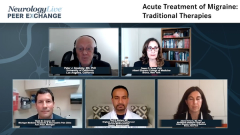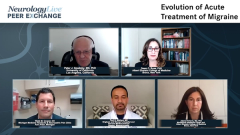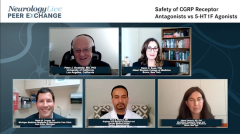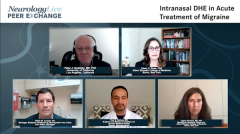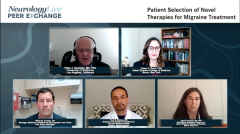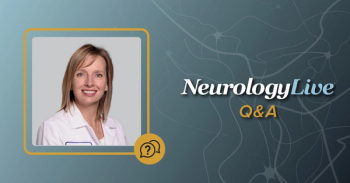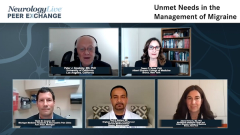
Intranasal DHE in Acute Treatment of Migraine
Episodes in this series

INP104, the intranasal formulation of DHE in development for the treatment of acute migraine, is examined along with its use as a treatment option for women of childbearing age.
Peter J. Goadsby, MD, PhD: We must not let listeners think that gepants and ditans are the only thing that’s happening. There are some reformulations of an old friend. Paul, can you tell us about what’s happening with dihydroergotamine [DHE]?
Paul G. Mathew, MD: To people’s surprise, dihydroergotamine has been around for a long time. When I say a long time, I mean DHE first came out in the 1940s. It takes me back to my fellowship, when I actually gave a lecture at Mayo Clinic called, “DHE: An Old Dog With New Tricks.” Way back then, the inhaled version of DHE was under development and Dr Wade Cooper was still playing varsity football in high school. It was quite a long time ago.
Unfortunately, that inhaled formulation never came to fruition, but that did not cause people to drop the ball. To give some background, DHE is 1 of those few drugs that unfortunately is not absorbed orally. You can try to try to take a tablet of it, but it’s not going to be absorbed. The only formulations that have been available are IV [intravenous], IM [intramuscular], subcutaneous, and inhaled. DHE gets a bad name because of its tolerability. It does cause significant nausea, so the vast majority of the time, it has to be codosed with an antiemetic.
My general rule of thumb is, if you can’t tolerate a triptan very well, you’re probably not going to tolerate DHE well. Intravenous DHE gives you a blood plasma level of 10 ng/mL at the time of administration, while the older intranasal forms gave a dose of 0.01 ng/mL. It’s a huge difference in plasma levels. Unfortunately, that IV dose was so high in terms of initial plasma dosing that people had trouble tolerating it, while the older intranasal forms were so low that patients didn’t get a consistent therapeutic benefit from it.
The 2 newer forms of DHE are both intranasal. One of them is a proprietary pump, which squirts the DHE into a particular part of the nose where it’s able to get absorbed much more consistently. It’s still in liquid formulation. The other is a small vial about this size. You squeeze it, and a powder form of DHE is injected into the nose.
These 2 proprietary delivery systems for DHE are quite encouraging because they reach plasma levels that are not as high as with the IV, subcutaneous, or IM administrations. They don’t cause a lot of those adverse effects, yet they’re able to deliver a much more consistent dose than the traditional intranasal formulation. That was very inconsistent in terms of dosing and rarely ever met the threshold of being able to effectively treat a headache.
It is exciting. For patients who don’t respond to triptans and don’t find some of these other agents useful, it’s a good option. The other place where I envision this being used, although this is not being looked at in studies, is in a patient who is status migrainosus. They have exhausted their oral home medications that Jelena had mentioned in a stepwise fashion. Oral steroids are not effective.
Nerve blocks are something you can consider in the office, urgent care, or emergency department. But if either of these formulations gets approved, there may potentially be a DHE protocol in which you give the patient a prescription and they can take 1 of these 2 intranasal formulations for a few days. That’s going to be potentially useful for when someone has status migrainosus that nothing else is working.
Peter J. Goadsby, MD, PhD: You certainly need to try to keep people out of emergency departments. If you have migraine, emergency departments are noisy. They’re loud. They don’t smell very good, and people move people about. It’s the reverse of the canonical migraine symptomatology. I tell people, “Could you think of a worse place to be, short of being thrown onto a freeway?
Jelena Pavlovic, MD, PhD: I was going to say, they have the harshest lights you can find anywhere.
Dawn C. Buse, PhD: Emergency departments are also the most likely place for opioids to be prescribed for migraine, and often with clinical reason. Without having a history, knowing someone’s tolerability and cardiovascular history, and without having a follow-up plan for the future, their treatment options are limited.
Peter J. Goadsby, MD, PhD: This is where I’d like to see a parenteral form of a ditan. You would never have a cardiovascular problem, it seems to me, if you thought someone had migraine and gave them a ditan. I can’t see how that could cause a catastrophic problem. Even if they were a bit dizzy afterward, so what, compared with the kinds of problems that we’re talking about? You can see that as the formulations get better, the options are there.
Dawn C. Buse, PhD: Paul, what advice do you have for women of childbearing age? How do you think about that as you’re considering DHE as a treatment option? Is that an area in which extra education and caution is required?
Paul G. Mathew, MD: Yes. It’s just like all the medications we’ve talked about. If someone is thinking about getting pregnant or gets pregnant, I often warn them to be in touch with their doctors regarding what medications are safe and not safe to continue during pregnancy. That certainly applies to the ditans, as well as to the gepants.
Although this might be getting a little ahead, that’s why gepants are particularly exciting, because everyone knows they are being studied for preventive therapy. With the new antibodies, there is concern that if someone of childbearing age is on an antibody and happens to get pregnant, there is no way to undo that. They just have to wait until it washes out of their system, while with a gepant, they can discontinue oral treatments and go from there.
Regarding pregnancy, the advice I give many of my patients is that—this is just my view—getting pregnant can take weeks, months or even years. To discontinue someone’s medications because they’re trying to get pregnant can really limit their ability to get pregnant and can lead to a lot of migraines and unnecessary suffering. My advice to these patients is, the minute you become pregnant, call your doctor. We’ll rapidly wean you off everything.
That’s a pretty practical approach, and unfortunately, I relate it to alcohol. Many people in this world do get pregnant while they’ve had a couple of drinks. Obviously, continued drinking while you’re pregnant is not a good idea. But there is no significant risk to the fetus if you stop drinking after conception. That’s the way I visualize medications as well.
Dawn C. Buse, PhD: That’s very good advice, Paul. In the CaMEO study, we found that 10% of women with chronic migraine chose not to have children or delayed having children because of concerns associated with their migraine care, either that they would pass on their migraine disease, that they would have to stop their medications, or that their migraine would get worse.
Anything we can do to treat them as well as possible, keep them comfortable, and allow them to make those lifestyle choices—including reproductive choices, which are core to being human—is important. I’m looking around. We’re all parents on this panel. It is pretty important. I also want to make 1 comment about the flip side. We’re thinking about protecting our pregnant women during pregnancy. We also need to think about how, as women age out of a childbearing age and get older, their risk for cardiac events might increase again. We may need to think about a woman who’s maybe been on a triptan for decades, since she was a teen or a young adult. It may be time to reconsider her options as she ages into the postmenopausal age bracket.
Paul G. Mathew, MD: I want to dovetail on your point, Dawn. As people who take care of headache patients, although it’s true that most women experience an improvement of their migraines during pregnancy, that should not be cavalierly thrown out to the patient by saying, “Oh, the best treatment is just to get pregnant. We’re going to discontinue everything, just get pregnant.” Although factual, that is not really helpful to the patient.
Jelena Pavlovic, MD, PhD: The challenge with migraine and pregnancy is a catch-22 of attempting conception. The patient needs to come off preventives to conceive, but is then burdened by migraines so heavily that she cannot conceive and ends up in an anxiety and chronic migraine cycle that’s unbreakable. In the meantime, time is passing, and with each year the genetic risk to her embryo increases more and more.
Dawn C. Buse, PhD: Jelena, you’re NIH [National Institutes of Health] funded in this area, so this is your sweet spot to talk about female hormones and migraine. Not everyone gets better during pregnancy. Sometimes we almost think it’s a third, a third, and a third. There is sometimes worsening in the first trimester. Sometimes, the second trimester is the sweet spot. In the third trimester and postpartum, there could be a dramatic drop.
It’s a bit of a roller coaster for women with migraine trying to guess what their pregnancy will be. We can’t afford child support for all the women we tell to get pregnant to treat their migraine. That’s a pretty big ask, to recommend that someone should have a child for their migraine to get better. It might not.
Jelena Pavlovic, MD, PhD: We need registries of all the new medications in pregnancy, because we know that women will inadvertently use them in early pregnancy before awareness that they are pregnant. These medications will be used, and having registries that are active and already started will be very helpful.
Peter J. Goadsby, MD, PhD: It was very helpful in the triptan era. The triptan pregnancy registry is a source of great reassurance, along with the various Scandinavian, particularly Norwegian, pregnancy data. Twenty years is a long time to collect that information, but it’s so important that it needs to be collected.
Newsletter
Keep your finger on the pulse of neurology—subscribe to NeurologyLive for expert interviews, new data, and breakthrough treatment updates.

